|
Malaysia is unusual in that some areas, tin and limestone are found together. In countries such as England, tin occurs in areas quite separate from limestone.
In Malaysia tin is found in some limestone areas, having been washed down from the granite ranges. These tin-bearing granites generally date to the Mesozoic era. The tin-bearing alluvium was possibly trapped by the buried karst and accumulated in rich deposits. Notable examples are in Perak and Perlis, as well as Selangor.
During the orogenic movements associated with the intrusion of the granite, the sedimentary rocks were folded into tectonic troughs. The granite cores between the tectonic troughs were exposed by consequen erosion, and various areas of sedimentary rocks were separated. Because of the relative softness of the sedimentary rocks, the original tectonic troughs have become topographical troughs and the resistant granite which separates them forms high ranges.
Tin mining is one of Malaysia's oldest and most successful industries. In the 1600's, this industry was beginning to thrive in Kedah, Perak and Selangor. In the heyday of tin mining in the mid 19th century Perak was one of the most active areas. There was an increased demand for tin by Chinese and Europeans and at the same time, extensive and rich deposits of tin were found in Perak and Selangor. With the arrival of labour from China and influx of capital, the tin industry rapidly expanded to become the largest in the world. More than 3000 Chinese arrived annually to work the mines.
SELANGOR
In the Klang Valley, i.e. Kuala Lumpur and parts of Selangor, the Lower Palaeozoic sediments are almost entirely surrounded by Mesozoic tin-bearing granites. The limestones and dolomites which form the upper part of the succession underlie extensive alluvial flats, on which the local tin mining was concentrated. The limestone hill of Batu Caves is the only natural exposure in the Kuala Lumpur area. Otherwise exposures of limestone are only found in open cast hydraulic tin mines. There were 50 working mines in 1963-64. During mining the overlying alluvium was removed and was mostly between 10-60 feet thick. After the pit was flooded or filled in. The Kuala Lumpur limestone is estimated to be 6000 feet thick, and contain fossils of the Middle or Upper Silurian age (Gobbett 1963).
PERAK
There are examples of tin-ore in limestone in Perak, mostly seen in the mines of the Kinta Valley. The Kinta Valley was the largest producer of tin ore in the world in the first half of the 20th century. Most of the workings were open cast, and remains of these sites can still be seen today, although there are not many active workings now. A dredge can be seen near Tanjung Tualang, see below.
The SUN 2 June 2008 reported that Perak may reopen mining land and issue permits for the development of the mining industry, as the world market price of tin had soared to record levels. Tin is now US$20,000 a tonne. The article went on to say that "Perak holds great potential in tapping natural limestone caves which are used as temples, granite features, and former mining pools like Gunung Lang which can all be repacked for geoconservation and geotourism", full article.
The Star 12 June 2013 reported an increase in mining in Perak. It said that "Tin mining activities in Perak is on the increase with 30 mines in operation now......the state was the number one producer of tin ore in the country with the lead taken by Rahman Hydraulic in Pengkalan Hulu that has existed for over 100 years, making it the oldest, exposed mine in the country." See full article.
Known caves which were worked for tin at Gunung Lanno were surveyed on the Lanno 2001 expedition. These include :
Gua Puncak (18/40) -
The cave turned out to be the biggest and longest found in Lanno. It has one enormous chamber, which we estimate to be the second largest chamber in Peninsular Malaysia, after Alam Chamber in Gua Tempurung. It is 190m long, 60m wide and more than 80m high. Although Gua Puncak is a natural cave it has been mined for tin, but I can find no mining records for this site. The cave length is 1584m. The entrance passages are small but have been enlarged by the miners. There are two underground lakes, presumably created by mining activities. Various mining relics can still be seen - parts of a palong, a concrete dam, and some tools, light bulbs. In April 2006 quarrying partly blocked the entrances to Gua Puncak and the cave was in danger of being lost forever.
Gua Gatsch (18/23) -
The only river cave in Gunung Lanno, this natural cave has been enlarged by tin miners to install a water pipe through the cave. As a result of mining, the cave has a layer of gooey mud kneedeep in places.
Gua Portal (18/38) -
A through cave which has been worked for tin.
Another Kinta Valley cave which has been mined is Six Mile Tunnel. This is located near Sunway City in Ipoh, by Gunung Datuk. A large housing estate is being built in the valley, and the swamp in front of the cave has been partially filled in, affecting the water level in the cave entrance. The cave still contains some relics left by the miners, and there are some nice stals, as well as bats and other cave fauna. The cave entrance is low and narrow (manmade) and is prone to flooding. There is no longer free access to the cave (since 2006), as it is being used for commercial (expensive) tours by Sunway City.
Other caves in the Kinta Valley have been used as short cut passages to access iron mines.
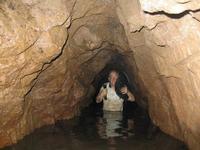
entrance passage, note shot hole on right |
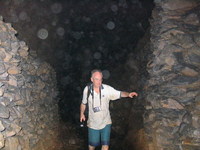
walls built by miners in Six Mile Tunnel |
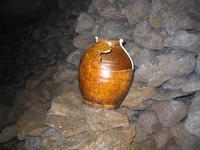
mining relic! |
PERLIS
Many of the natural caves in Perlis have been dug extensively for tin, although are no longer worked. The caves in the Setul Mountain Range in Perlis are different from those found in the rest of Peninsula Malaysia as they have great depth and also have rivers flowing through them. There are flooded chambers, underground lakes, calcite formations, as well as manmade remains of old railway lines, engine rooms, wooden walkways, steps carved into rock, as well as smaller mining artifacts.
Gua Kelam 2 -
The second longest cave in Peninsular Malaysia at 3748m. A river cave with some huge natural chambers and lots of relics from the mining era. It has now been partly developed and is used for adventure caving.
Gua Kelam 1 -
Gua Kelam is a tunnel through the hill used as a short cut by the miners.
There are several other caves which have been worked for tin, in 1960 there were at least 25 mines in operation.
Visiting the cave mines in Perlis is something like stepping into an Indiana Jones film. There are old railway lines, some of which are suspended over deep drops, others are across deep pools. Many are covered with glutinous mud, others are literally hanging by a thread. There are hooks protruding from the walls and cables lying all over the place. Large metal pipes and sluice gates, stone walls built to dump waste spoil behind, and old machinery all add to the scene. The rate of deposition of calcite is rather quick in the tropics, and many of the mining relices are already covered in calcite. Some of the wooden props are covered with fungus.
For a more detailed report, see ACG expedition
Working in the cave mines was potentially dangerous and accidents occured, resulting in deaths. Many people believe there are spirits in the cave, and offerings are made to them (fruit, cake, drinks).
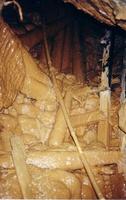
wooden ladder & cables covered in calcite, Gua Kelam 2 |
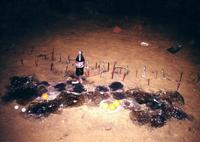
offerings to cave spirits |
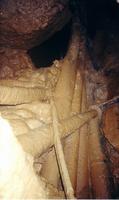
metal pipes covered in calcite, Gua Kelam 2 |
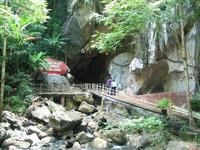
Gua Kelam 1 entrance |
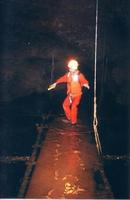
caver negotiating a slippery, muddy wooden plank across a deep pool |
TIN DREDGES
Although this has nothing to do with caves, I find tin mining to be an interesting subject. Sadly there are probably only two old tin dredges left in the country, 1 in Selangor (which can be seen when flying in/out from KLIA) and 1 in Perak. There were 2 in Selangor until about 2007 when one was sold and sent overseas. The one in Perak, TT5, is at Chenderong, near Tanjung Tualang. In 2005 there were plans to save the dredge and turn it into a tourist museum. Work began but the project was never completed. Then in Apr 2007 similar plans were revived. The dredge finally opened to the public in Feb 2008, and packages include guided tours inside the dredge, a trip to a tin mining museum and in the future there will be movies on how the 4,500 tonne giant works. However in Nov 2009 it was announced that funds were needed to save the dredge from sinking, it has started tilting and the pontoons need repairing. Tours are now resticted to the lower deck. I hope there will be enough interest to save this piece of Malaysia's industrial heritage.
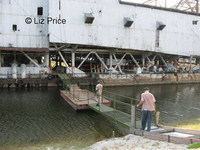
entering the dredge |
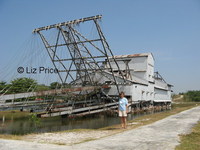
dredge at Tanjung Tualang |
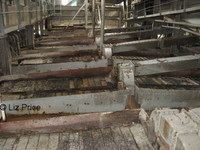
the jigs |
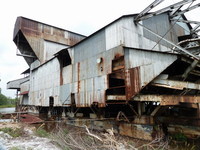
dredge at Dengkil, Selangor |

|
See more on Selangor Dreding history.
© Liz Price 2005 - 2013
Last updated 15 July 2013
|